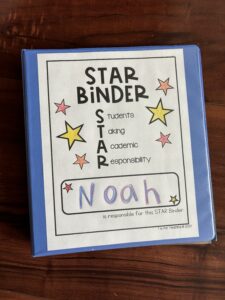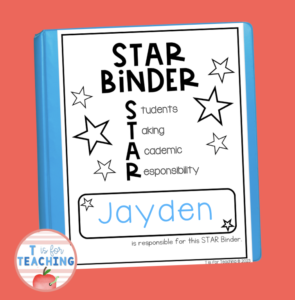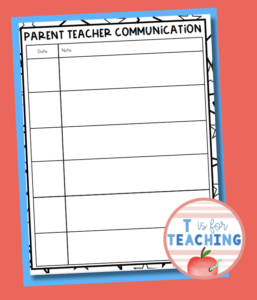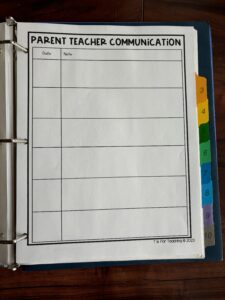STAR Binders are a resource I have used every year in my teaching career for home-school communication! They were once called FISH Binders, but the concept has stayed the same. These binders serve as a vital communication tool between home and school, ensuring that important information is easily accessible for both students and parents. Over the years, I have found that STAR Binders not only help keep students organized but also foster a sense of responsibility and independence.

What does STAR stand for?
STAR stands for
Students
Taking
Academic
Responsibility
But it could also mean..
Students Transforming Academic Responsibility
Students Taking Achievement Responsibility
What are STAR Binders used for?
STAR Binders are the primary means of communication between teachers, parents, and students. They ensure that important papers, homework, test scores, and flyers travel between home and school.
While digital communication through apps, emails, and the internet is common, there’s still value in paper-and-pencil communication. Younger students often lack access to digital tools, making physical documents essential for keeping everyone informed and organized. Additionally, STAR Binders give students a sense of responsibility and ownership over their learning and communication.
What do I put in STAR Binders?
1. Cover

First I included the cover page on the clear plastic sleeve of the binder, which students decorate sometime during the first few days of school. I also have them write their name in the box so they also feel ownership. It makes a great activity as students come in as morning work. They can always finish coloring at home or another morning.
2. Rules and Expectations

Then, we go over the rules and expectations so students and parents understand what a STAR binder is and how it will be used. We make this fun and silly by asking questions like, “Should your STAR binder go in the bath with you?!” to emphasize the importance of keeping water away from the binder.
I also heavily emphasize THEY are in charge of their STAR Binders. I really try to enforce this is their responsibility.

3. Monthly Reading Log
The monthly reading log serves as the students’ reading homework. While I don’t assign a lot of homework to the entire class, I do provide it on a need basis, tailored to what each student actually requires.
If you’re familiar with the Leader In Me philosophy, their program includes Wildly Important Goals (WIGs). My students create their own reading goals, with my encouragement to read for at least 20-30 minutes, five days a week.
A few days a week, towards the end of our morning meeting, students partner up with their WIG partner to discuss their progress toward their reading goals. Together, we brainstorm strategies to help them achieve these goals.
The monthly reading logs are available in two formats if you’d like to use them too. One that is editable and customizable with a parent signature, and another that is a simple print-and-go option, which is the one I use.
You can find them here.

4. Daily Reflection Sheet
These daily reflection sheets were a total game changer in my classroom! I’m not going to lie, the copies are a lot. I copy one for every child, every week BUT the way it fosters accountability, reflection, gratitude, and conversations is TOTALLY worth it.
Both principals I’ve had seen them in action and are always impressed. And if they didn’t have a chance to see them in action, it was coincidence that they did see them rather than intentional, I would bring them to my evaluation. My evaluations have always included domains if students are self-reflecting which this promotes!
So in lue of using a planner, I copy these daily reflection sheets. Depending on my school, sometimes it is required to use the planner so students place this sheet in the planner for the specific week.
The procedure:
- Students are called to grab their STAR Binders from their homes
- They write what they did good at, what they could improve at, and what they are grateful for
- Sometimes if we are short on time, they only have to fill out one or two categories. I let them know what is expected. Also, sometimes if they cannot think of what they can improve on, they do not fill out that part but I do emphasize we can all improve and are never perfect.
- I also emphasize being SPECIFIC. This requires modeling and going over what we did during the day so students remember what they may have done well at or could improve at. “Remember we did two digit addition in math today, we read about Simon Biles in reading to locate key details, and in science we categorized rocks.” If a student writes I did great at.. “Math” then I prompt them to ask what did they do well at during math?
- Student’s raise their hand (the norm) or bring it to me in a line (occasionally), then I sign it by drawing a smiley face.
- When I read it, I also have a brief conversation of “You’re right, you did great at math today. I’m so proud of you!” which builds our relationship. Or the alternative is “You’re right, you could improve at raising your hand. What could we do tomorrow to help meet that goal?” Then we problem solve to help improvement. The student’s isn’t alone with the problem plus that child also wrote a positive about what they did well at so usually that helps cheer them up.
Benefits I’ve witnessed:
- Students reflect on their day and consider what they did well, which boosts their self-esteem. If they cannot think of anything, I take the opportunity to highlight several things they excelled at, giving them options to write down.
- This process leads to relationship building, as students engage in conversations with me about their achievements.
- Students also understand that making mistakes and improving are part of the journey. Each day, we discuss areas for improvement, and they write down what they could work on. For example, if I had to prompt a student to raise their hand several times, the student writes, “I could improve at raising my hand.” This is not a negative note to take home; it’s an honest reflection of the day and an opportunity for growth. It’s not shameful. It’s important to note that the student writes it. While I occasionally write it depending on the situation and the student, the goal is for the student to do it.
- Students also look for positive parts of their day they are grateful for, capturing their gratitude daily. They often express gratitude for their parents, which I think parents love to see. This practice further strengthens the relationship between student, parent, and teacher.
5. Parent Communication Log

If I am not using a planner then I insert about 5 parent communication logs incase parents need to write a note to me. With apps for communication, these do get used less and less but my schools have required parents to write if their child has a change of dismissal, so some write that change on here.

STAR Binder Procedures and Storage
The arrival procedures include unpacking student’s STAR Binders. They enter the classroom, choose a greeting to greet me with (hug, handshake, high five), then unpack their backpacks. This includes putting their STAR Binders on a counter in a designated area.
I find this keeps the STAR Binders in better condition and I can easily grab one if I need to write a note and insert any paperwork.
It also helps the accountability piece of everyday I take it out and this is my responsibility.
Final Thoughts
Implementing STAR Binders has significantly improved communication, organization, and responsibility in my classroom. By fostering a sense of ownership and accountability, students become more engaged in their learning journey. These binders not only streamline daily routines but also strengthen the relationships between students, parents, and teachers.
Also an organization thought:
The front pocket tends to be papers to come back to school and the back pocket could be papers to stay home but after years of labeling them, the papers usually all just end up in the front so I stopped labeling them.
You can find all the other necessities I keep in my student’ STAR Binder here.















